ACCT6003 Financial Accounting Processes: Company Transactions
VerifiedAdded on 2023/06/13
|14
|1878
|147
Report
AI Summary
This report delves into the financial accounting processes of Chi Herbal Ltd, covering various scenarios including financing company operations, property, plant, and equipment, leases, and intangible assets. It presents journal entries for share capital transactions, calculations for lease interest rates, and an analysis of intangible assets according to AASB 138. The report includes detailed accounting treatments for research and development costs, legal expenses for patent registration, and marketing campaign costs. Furthermore, it evaluates the financial implications of a potential offer for the company, contrasting it with the expenses incurred. This comprehensive analysis provides a thorough understanding of the accounting procedures and financial considerations relevant to Chi Herbal Ltd's operations.
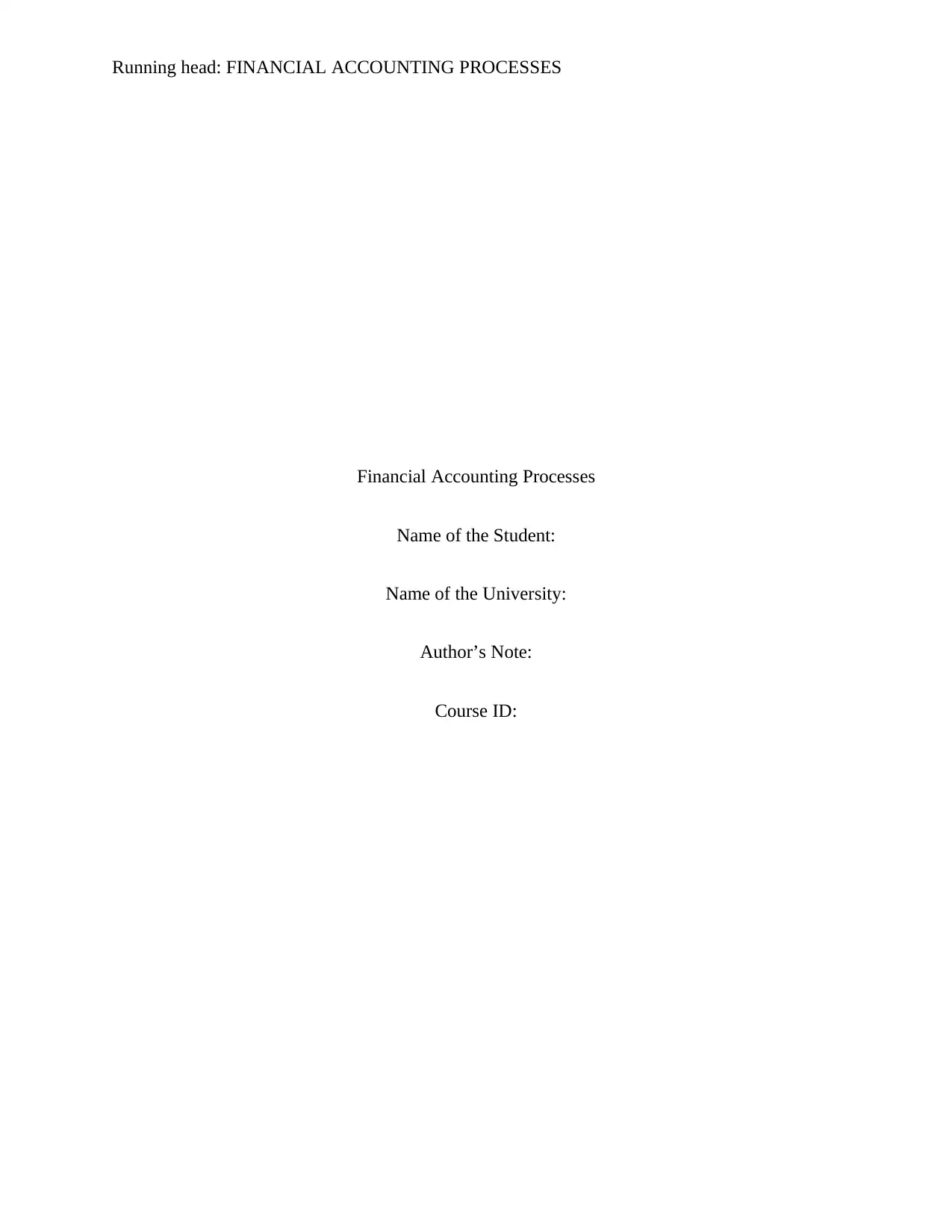
Running head: FINANCIAL ACCOUNTING PROCESSES
Financial Accounting Processes
Name of the Student:
Name of the University:
Author’s Note:
Course ID:
Financial Accounting Processes
Name of the Student:
Name of the University:
Author’s Note:
Course ID:
Paraphrase This Document
Need a fresh take? Get an instant paraphrase of this document with our AI Paraphraser
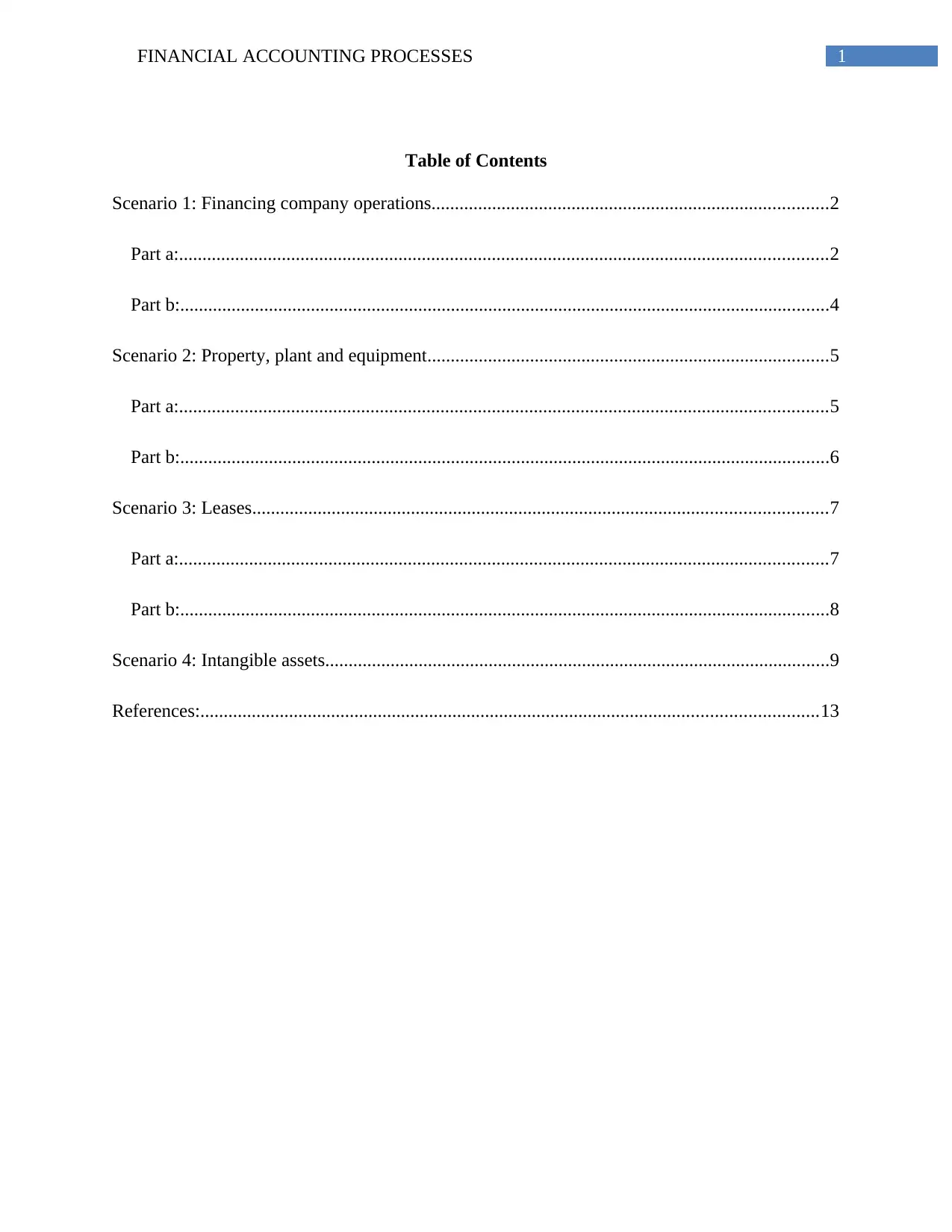
1FINANCIAL ACCOUNTING PROCESSES
Table of Contents
Scenario 1: Financing company operations.....................................................................................2
Part a:...........................................................................................................................................2
Part b:...........................................................................................................................................4
Scenario 2: Property, plant and equipment......................................................................................5
Part a:...........................................................................................................................................5
Part b:...........................................................................................................................................6
Scenario 3: Leases...........................................................................................................................7
Part a:...........................................................................................................................................7
Part b:...........................................................................................................................................8
Scenario 4: Intangible assets............................................................................................................9
References:....................................................................................................................................13
Table of Contents
Scenario 1: Financing company operations.....................................................................................2
Part a:...........................................................................................................................................2
Part b:...........................................................................................................................................4
Scenario 2: Property, plant and equipment......................................................................................5
Part a:...........................................................................................................................................5
Part b:...........................................................................................................................................6
Scenario 3: Leases...........................................................................................................................7
Part a:...........................................................................................................................................7
Part b:...........................................................................................................................................8
Scenario 4: Intangible assets............................................................................................................9
References:....................................................................................................................................13
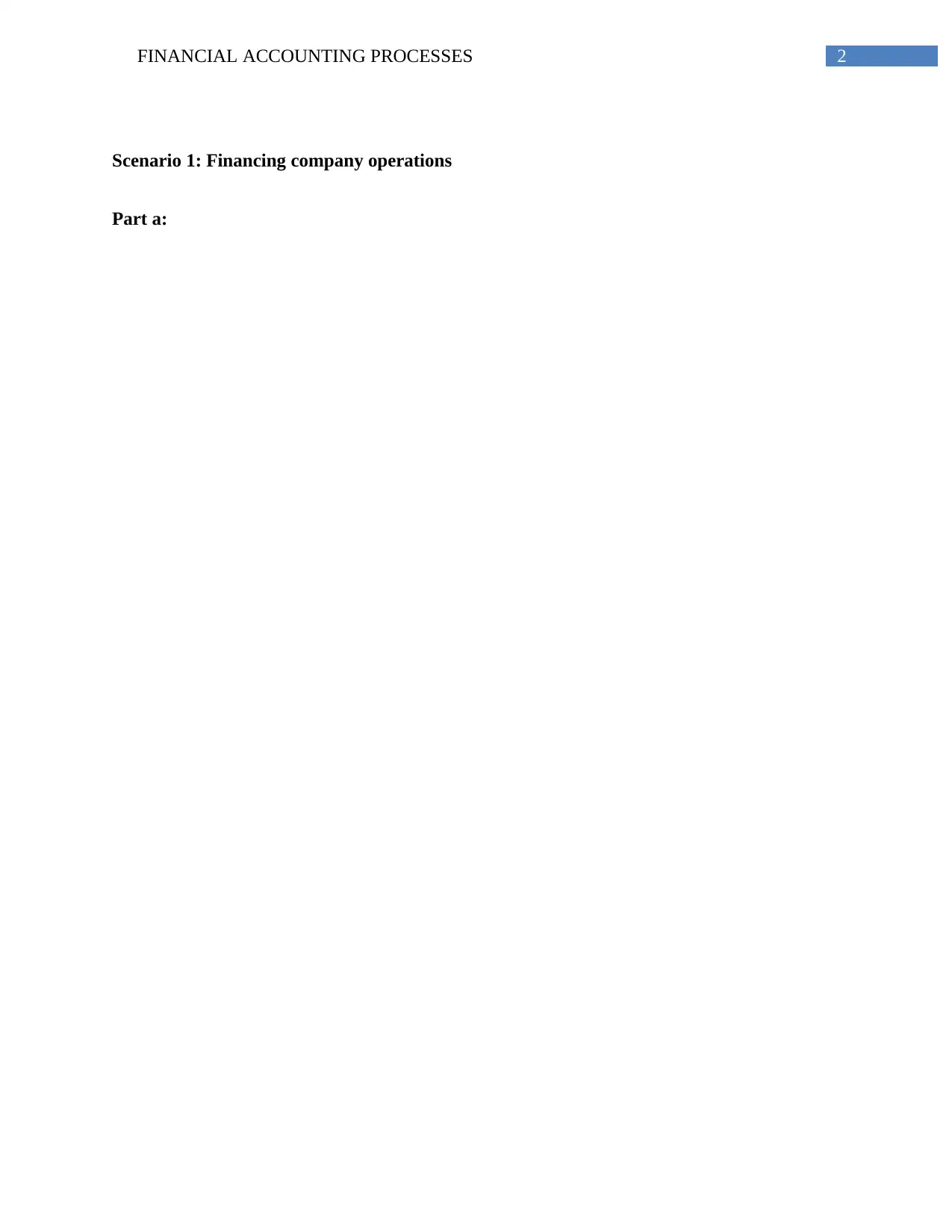
2FINANCIAL ACCOUNTING PROCESSES
Scenario 1: Financing company operations
Part a:
Scenario 1: Financing company operations
Part a:
⊘ This is a preview!⊘
Do you want full access?
Subscribe today to unlock all pages.

Trusted by 1+ million students worldwide
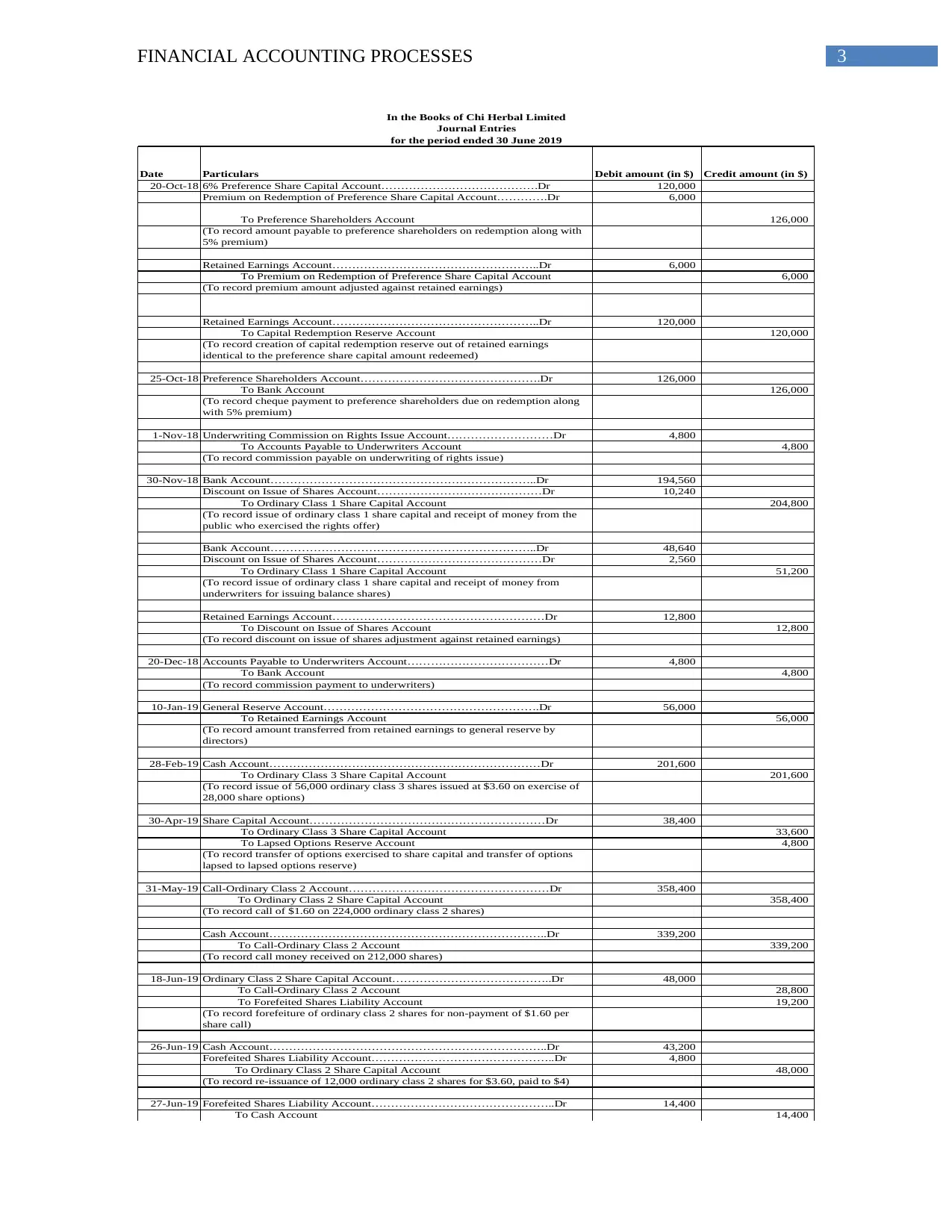
3FINANCIAL ACCOUNTING PROCESSES
Date Particulars Debit amount (in $) Credit amount (in $)
20-Oct-18 6% Preference Share Capital Account………………………………….Dr 120,000
Premium on Redemption of Preference Share Capital Account………….Dr 6,000
To Preference Shareholders Account 126,000
(To record amount payable to preference shareholders on redemption along with
5% premium)
Retained Earnings Account……………………………………………..Dr 6,000
To Premium on Redemption of Preference Share Capital Account 6,000
(To record premium amount adjusted against retained earnings)
Retained Earnings Account……………………………………………..Dr 120,000
To Capital Redemption Reserve Account 120,000
(To record creation of capital redemption reserve out of retained earnings
identical to the preference share capital amount redeemed)
25-Oct-18 Preference Shareholders Account……………………………………….Dr 126,000
To Bank Account 126,000
(To record cheque payment to preference shareholders due on redemption along
with 5% premium)
1-Nov-18 Underwriting Commission on Rights Issue Account………………………Dr 4,800
To Accounts Payable to Underwriters Account 4,800
(To record commission payable on underwriting of rights issue)
30-Nov-18 Bank Account…………………………………………………………..Dr 194,560
Discount on Issue of Shares Account……………………………………Dr 10,240
To Ordinary Class 1 Share Capital Account 204,800
(To record issue of ordinary class 1 share capital and receipt of money from the
public who exercised the rights offer)
Bank Account…………………………………………………………..Dr 48,640
Discount on Issue of Shares Account……………………………………Dr 2,560
To Ordinary Class 1 Share Capital Account 51,200
(To record issue of ordinary class 1 share capital and receipt of money from
underwriters for issuing balance shares)
Retained Earnings Account………………………………………………Dr 12,800
To Discount on Issue of Shares Account 12,800
(To record discount on issue of shares adjustment against retained earnings)
20-Dec-18 Accounts Payable to Underwriters Account………………………………Dr 4,800
To Bank Account 4,800
(To record commission payment to underwriters)
10-Jan-19 General Reserve Account……………………………………………….Dr 56,000
To Retained Earnings Account 56,000
(To record amount transferred from retained earnings to general reserve by
directors)
28-Feb-19 Cash Account……………………………………………………………Dr 201,600
To Ordinary Class 3 Share Capital Account 201,600
(To record issue of 56,000 ordinary class 3 shares issued at $3.60 on exercise of
28,000 share options)
30-Apr-19 Share Capital Account……………………………………………………Dr 38,400
To Ordinary Class 3 Share Capital Account 33,600
To Lapsed Options Reserve Account 4,800
(To record transfer of options exercised to share capital and transfer of options
lapsed to lapsed options reserve)
31-May-19 Call-Ordinary Class 2 Account……………………………………………Dr 358,400
To Ordinary Class 2 Share Capital Account 358,400
(To record call of $1.60 on 224,000 ordinary class 2 shares)
Cash Account……………………………………………………………..Dr 339,200
To Call-Ordinary Class 2 Account 339,200
(To record call money received on 212,000 shares)
18-Jun-19 Ordinary Class 2 Share Capital Account…………………………………..Dr 48,000
To Call-Ordinary Class 2 Account 28,800
To Forefeited Shares Liability Account 19,200
(To record forefeiture of ordinary class 2 shares for non-payment of $1.60 per
share call)
26-Jun-19 Cash Account……………………………………………………………..Dr 43,200
Forefeited Shares Liability Account………………………………………..Dr 4,800
To Ordinary Class 2 Share Capital Account 48,000
(To record re-issuance of 12,000 ordinary class 2 shares for $3.60, paid to $4)
27-Jun-19 Forefeited Shares Liability Account………………………………………..Dr 14,400
To Cash Account 14,400
(To record payment of refund to former shareholders)
In the Books of Chi Herbal Limited
Journal Entries
for the period ended 30 June 2019
Date Particulars Debit amount (in $) Credit amount (in $)
20-Oct-18 6% Preference Share Capital Account………………………………….Dr 120,000
Premium on Redemption of Preference Share Capital Account………….Dr 6,000
To Preference Shareholders Account 126,000
(To record amount payable to preference shareholders on redemption along with
5% premium)
Retained Earnings Account……………………………………………..Dr 6,000
To Premium on Redemption of Preference Share Capital Account 6,000
(To record premium amount adjusted against retained earnings)
Retained Earnings Account……………………………………………..Dr 120,000
To Capital Redemption Reserve Account 120,000
(To record creation of capital redemption reserve out of retained earnings
identical to the preference share capital amount redeemed)
25-Oct-18 Preference Shareholders Account……………………………………….Dr 126,000
To Bank Account 126,000
(To record cheque payment to preference shareholders due on redemption along
with 5% premium)
1-Nov-18 Underwriting Commission on Rights Issue Account………………………Dr 4,800
To Accounts Payable to Underwriters Account 4,800
(To record commission payable on underwriting of rights issue)
30-Nov-18 Bank Account…………………………………………………………..Dr 194,560
Discount on Issue of Shares Account……………………………………Dr 10,240
To Ordinary Class 1 Share Capital Account 204,800
(To record issue of ordinary class 1 share capital and receipt of money from the
public who exercised the rights offer)
Bank Account…………………………………………………………..Dr 48,640
Discount on Issue of Shares Account……………………………………Dr 2,560
To Ordinary Class 1 Share Capital Account 51,200
(To record issue of ordinary class 1 share capital and receipt of money from
underwriters for issuing balance shares)
Retained Earnings Account………………………………………………Dr 12,800
To Discount on Issue of Shares Account 12,800
(To record discount on issue of shares adjustment against retained earnings)
20-Dec-18 Accounts Payable to Underwriters Account………………………………Dr 4,800
To Bank Account 4,800
(To record commission payment to underwriters)
10-Jan-19 General Reserve Account……………………………………………….Dr 56,000
To Retained Earnings Account 56,000
(To record amount transferred from retained earnings to general reserve by
directors)
28-Feb-19 Cash Account……………………………………………………………Dr 201,600
To Ordinary Class 3 Share Capital Account 201,600
(To record issue of 56,000 ordinary class 3 shares issued at $3.60 on exercise of
28,000 share options)
30-Apr-19 Share Capital Account……………………………………………………Dr 38,400
To Ordinary Class 3 Share Capital Account 33,600
To Lapsed Options Reserve Account 4,800
(To record transfer of options exercised to share capital and transfer of options
lapsed to lapsed options reserve)
31-May-19 Call-Ordinary Class 2 Account……………………………………………Dr 358,400
To Ordinary Class 2 Share Capital Account 358,400
(To record call of $1.60 on 224,000 ordinary class 2 shares)
Cash Account……………………………………………………………..Dr 339,200
To Call-Ordinary Class 2 Account 339,200
(To record call money received on 212,000 shares)
18-Jun-19 Ordinary Class 2 Share Capital Account…………………………………..Dr 48,000
To Call-Ordinary Class 2 Account 28,800
To Forefeited Shares Liability Account 19,200
(To record forefeiture of ordinary class 2 shares for non-payment of $1.60 per
share call)
26-Jun-19 Cash Account……………………………………………………………..Dr 43,200
Forefeited Shares Liability Account………………………………………..Dr 4,800
To Ordinary Class 2 Share Capital Account 48,000
(To record re-issuance of 12,000 ordinary class 2 shares for $3.60, paid to $4)
27-Jun-19 Forefeited Shares Liability Account………………………………………..Dr 14,400
To Cash Account 14,400
(To record payment of refund to former shareholders)
In the Books of Chi Herbal Limited
Journal Entries
for the period ended 30 June 2019
Paraphrase This Document
Need a fresh take? Get an instant paraphrase of this document with our AI Paraphraser
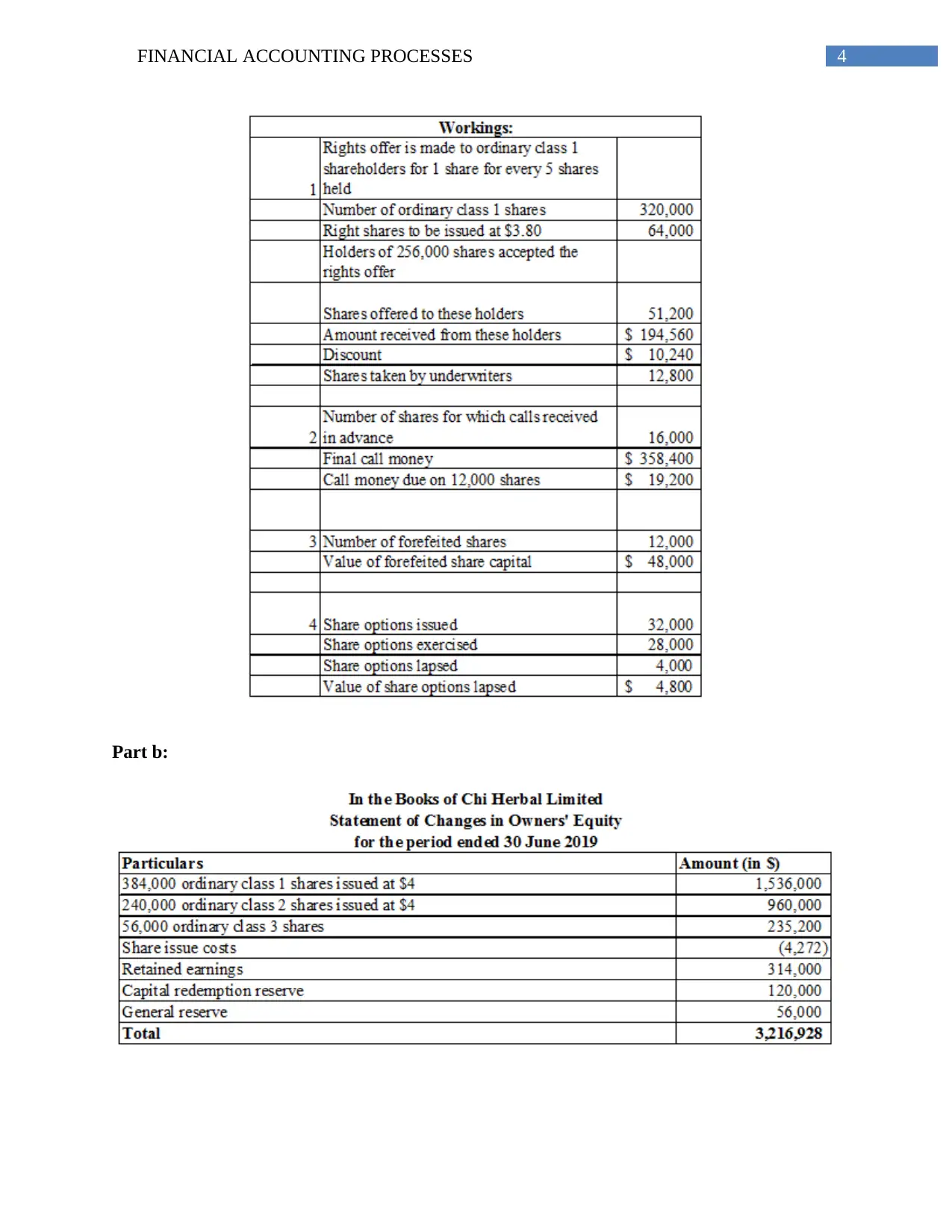
4FINANCIAL ACCOUNTING PROCESSES
Part b:
Part b:
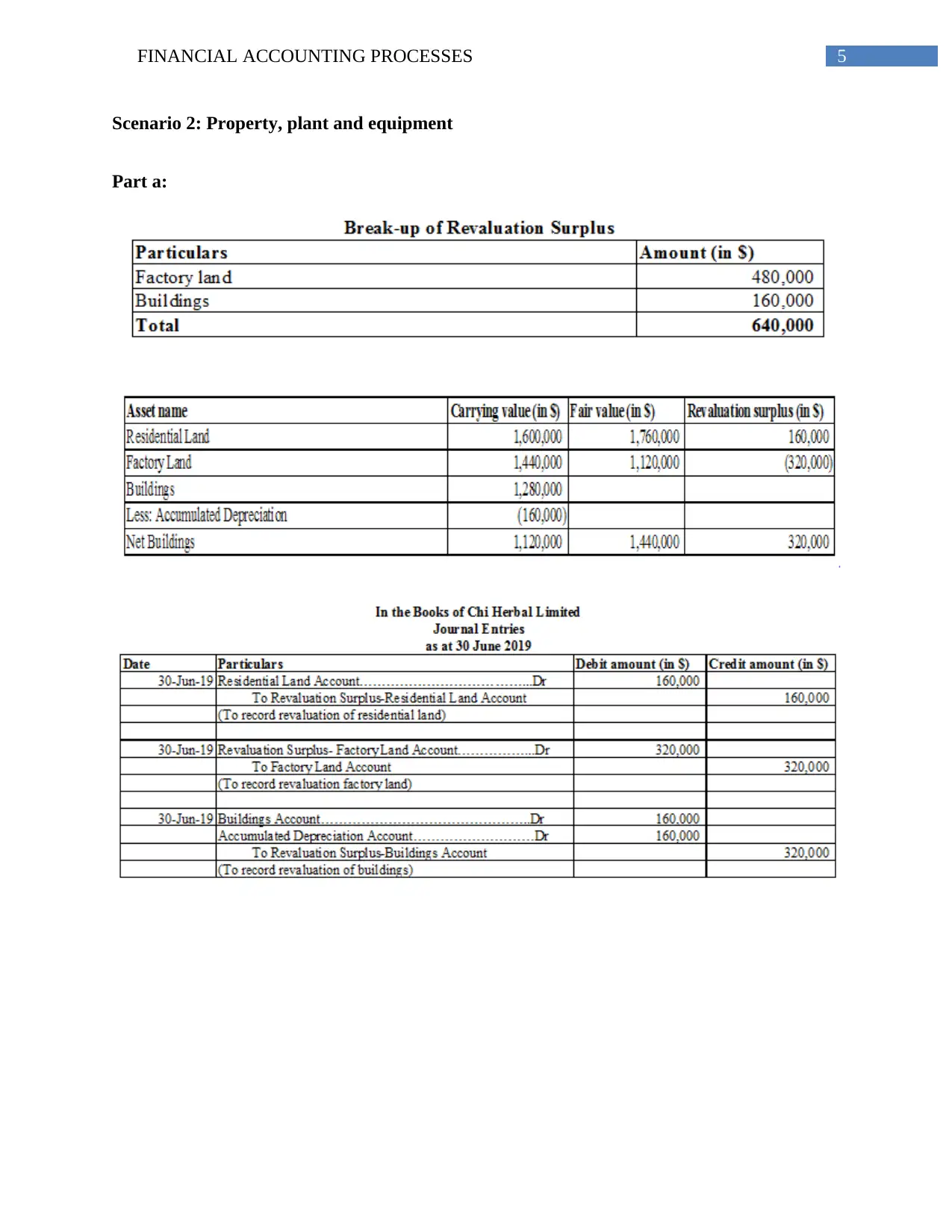
5FINANCIAL ACCOUNTING PROCESSES
Scenario 2: Property, plant and equipment
Part a:
Scenario 2: Property, plant and equipment
Part a:
⊘ This is a preview!⊘
Do you want full access?
Subscribe today to unlock all pages.

Trusted by 1+ million students worldwide
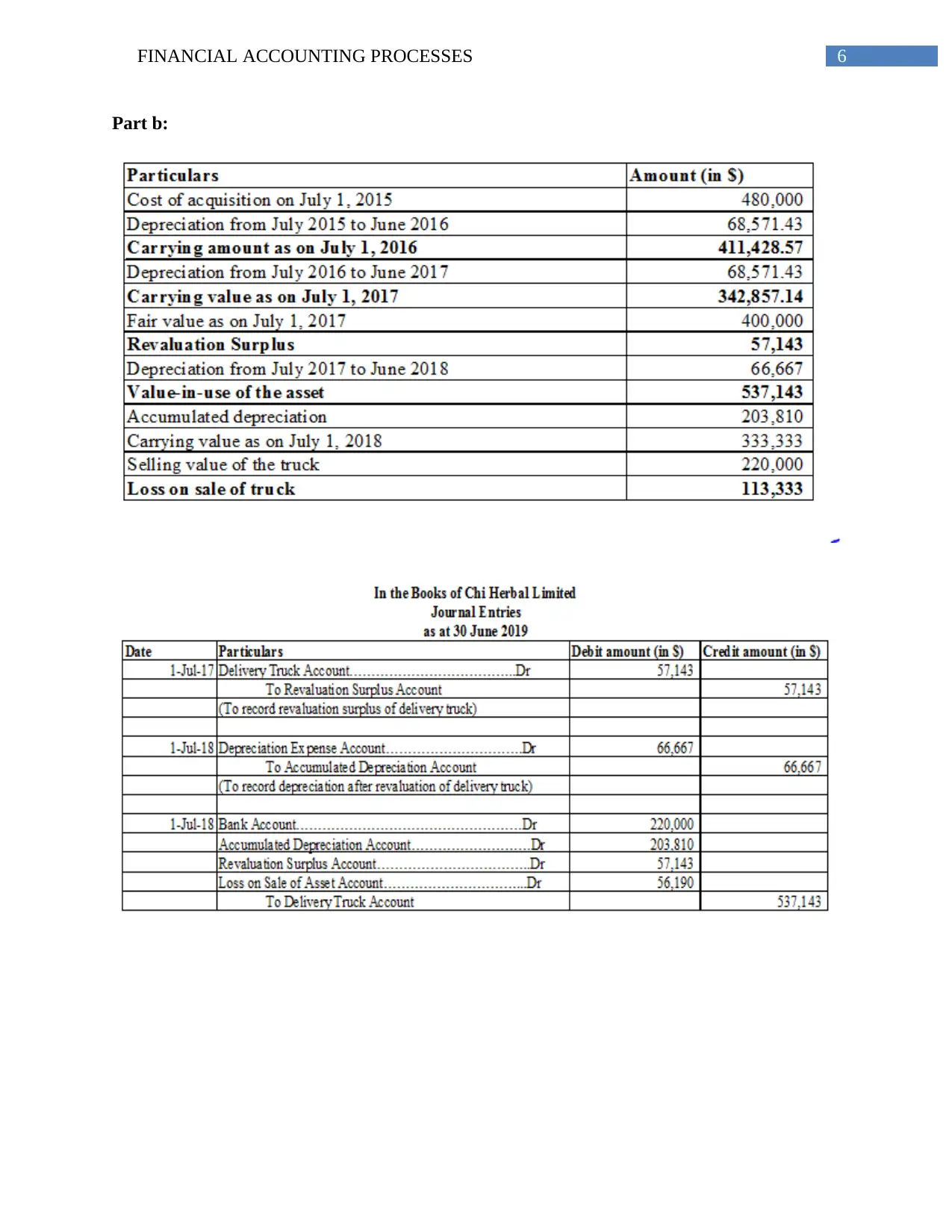
6FINANCIAL ACCOUNTING PROCESSES
Part b:
Part b:
Paraphrase This Document
Need a fresh take? Get an instant paraphrase of this document with our AI Paraphraser
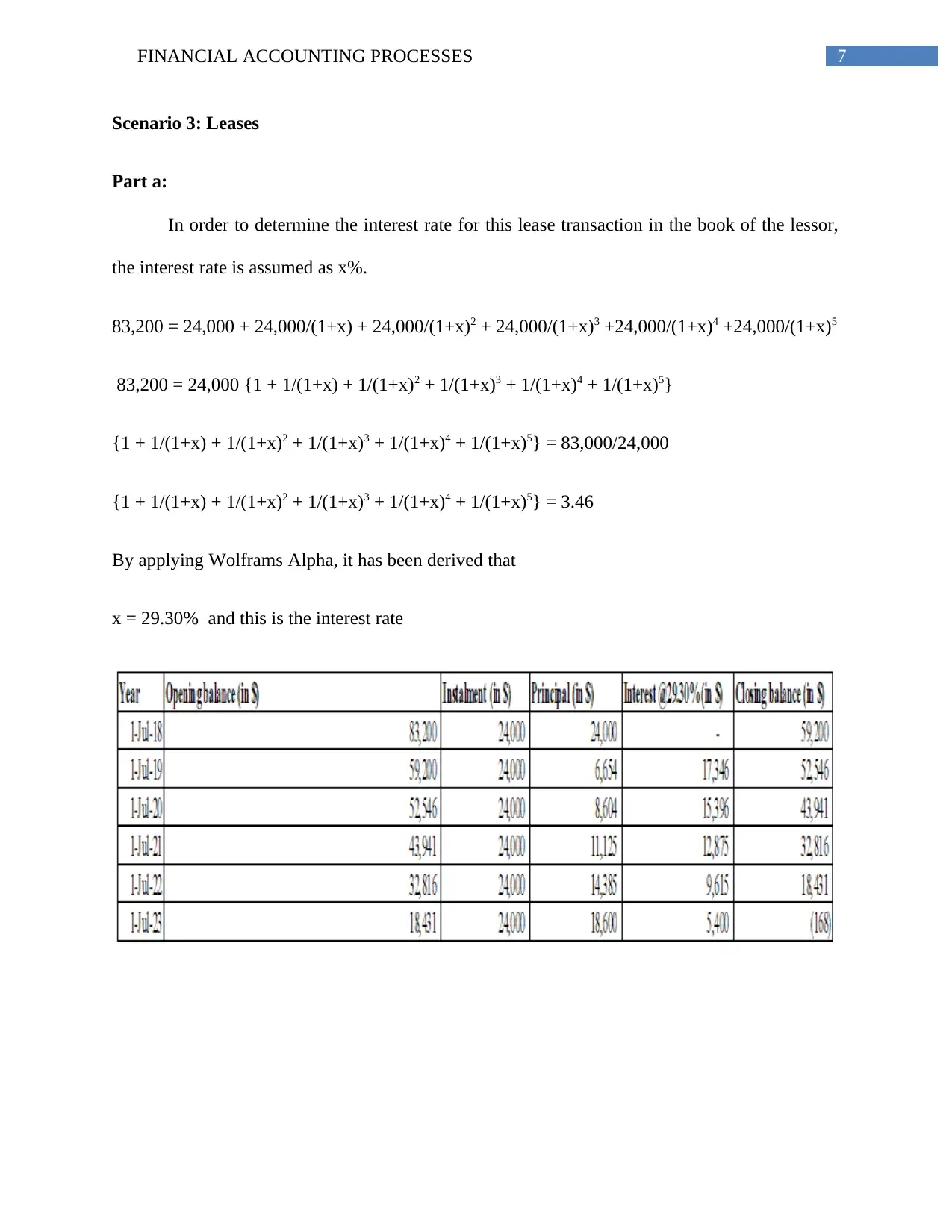
7FINANCIAL ACCOUNTING PROCESSES
Scenario 3: Leases
Part a:
In order to determine the interest rate for this lease transaction in the book of the lessor,
the interest rate is assumed as x%.
83,200 = 24,000 + 24,000/(1+x) + 24,000/(1+x)2 + 24,000/(1+x)3 +24,000/(1+x)4 +24,000/(1+x)5
83,200 = 24,000 {1 + 1/(1+x) + 1/(1+x)2 + 1/(1+x)3 + 1/(1+x)4 + 1/(1+x)5}
{1 + 1/(1+x) + 1/(1+x)2 + 1/(1+x)3 + 1/(1+x)4 + 1/(1+x)5} = 83,000/24,000
{1 + 1/(1+x) + 1/(1+x)2 + 1/(1+x)3 + 1/(1+x)4 + 1/(1+x)5} = 3.46
By applying Wolframs Alpha, it has been derived that
x = 29.30% and this is the interest rate
Scenario 3: Leases
Part a:
In order to determine the interest rate for this lease transaction in the book of the lessor,
the interest rate is assumed as x%.
83,200 = 24,000 + 24,000/(1+x) + 24,000/(1+x)2 + 24,000/(1+x)3 +24,000/(1+x)4 +24,000/(1+x)5
83,200 = 24,000 {1 + 1/(1+x) + 1/(1+x)2 + 1/(1+x)3 + 1/(1+x)4 + 1/(1+x)5}
{1 + 1/(1+x) + 1/(1+x)2 + 1/(1+x)3 + 1/(1+x)4 + 1/(1+x)5} = 83,000/24,000
{1 + 1/(1+x) + 1/(1+x)2 + 1/(1+x)3 + 1/(1+x)4 + 1/(1+x)5} = 3.46
By applying Wolframs Alpha, it has been derived that
x = 29.30% and this is the interest rate
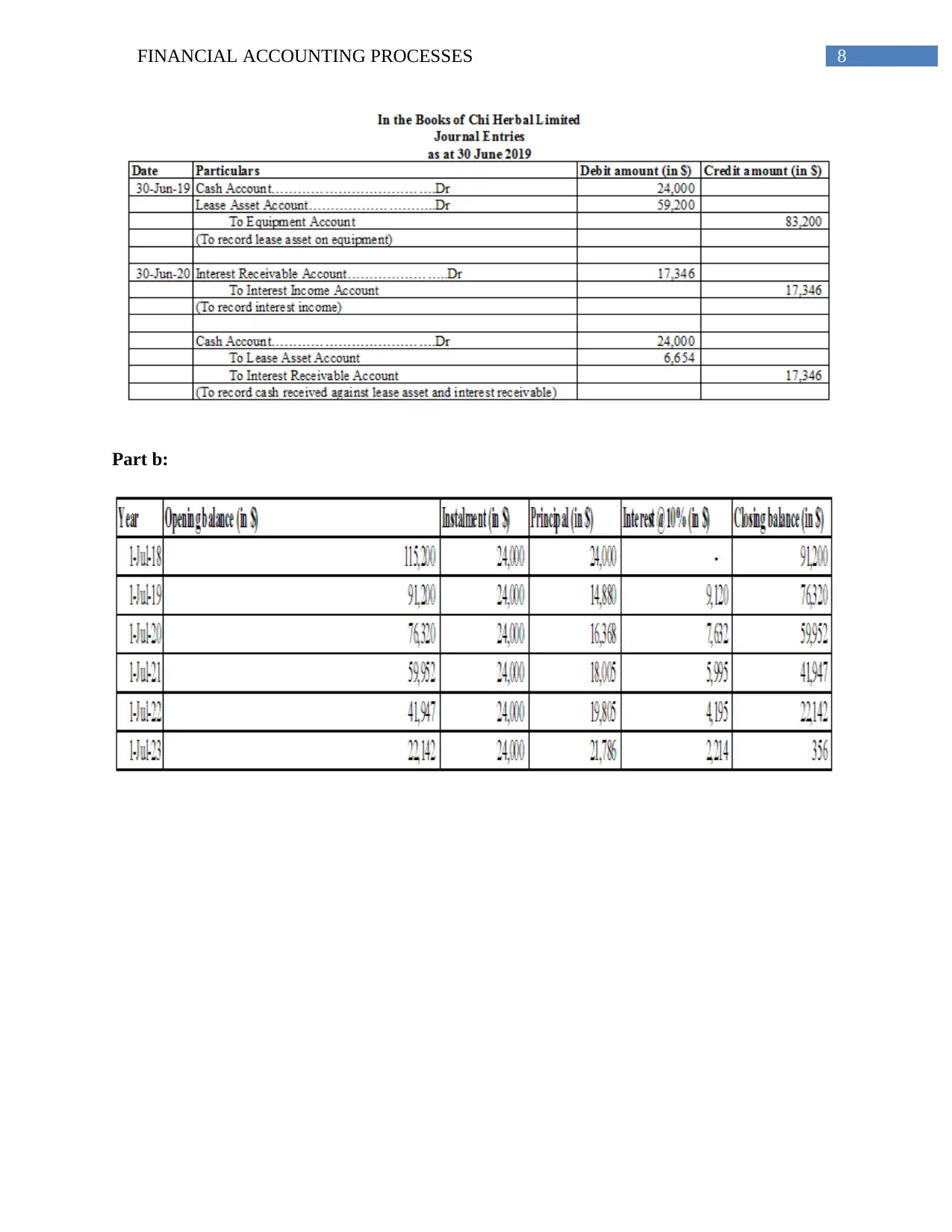
8FINANCIAL ACCOUNTING PROCESSES
Part b:
Part b:
⊘ This is a preview!⊘
Do you want full access?
Subscribe today to unlock all pages.

Trusted by 1+ million students worldwide
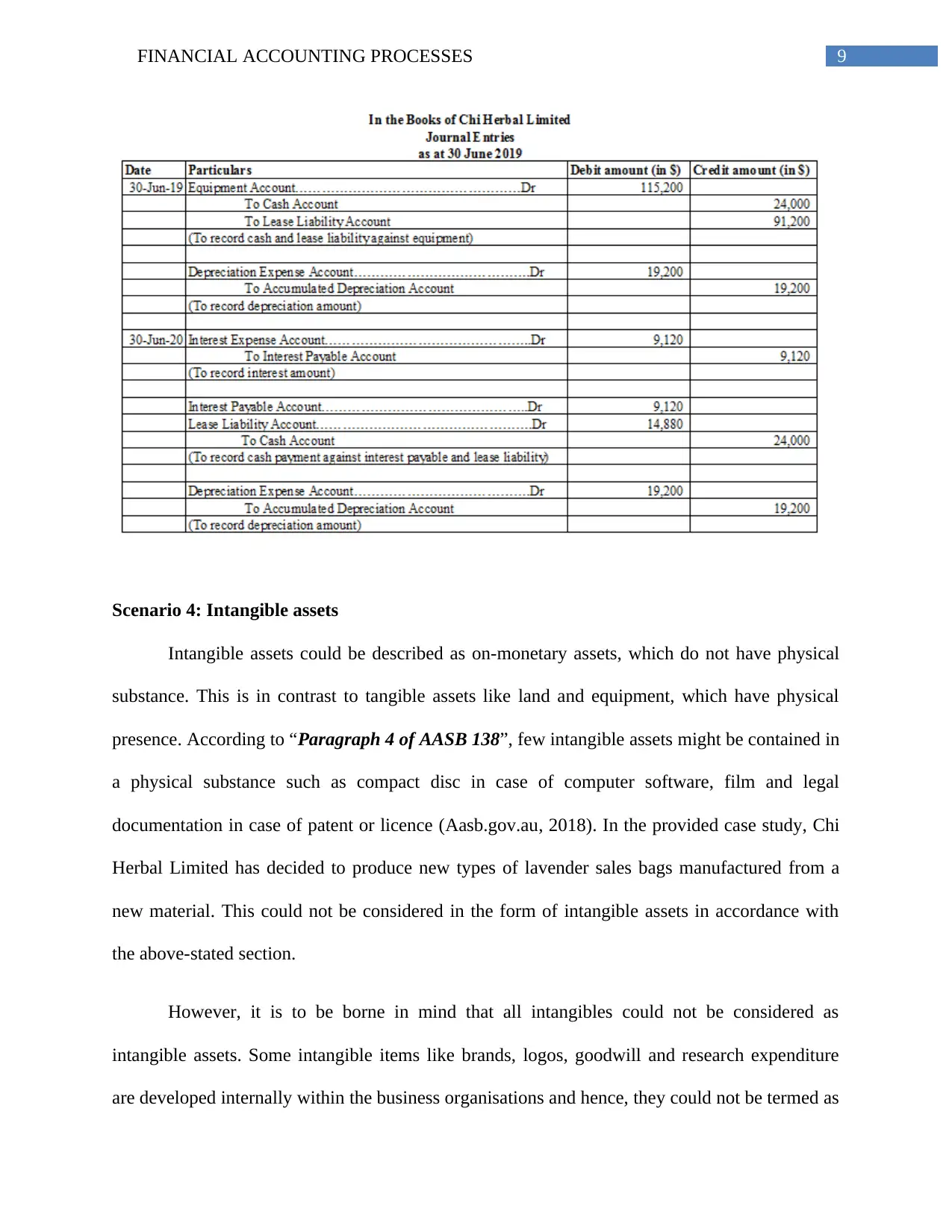
9FINANCIAL ACCOUNTING PROCESSES
Scenario 4: Intangible assets
Intangible assets could be described as on-monetary assets, which do not have physical
substance. This is in contrast to tangible assets like land and equipment, which have physical
presence. According to “Paragraph 4 of AASB 138”, few intangible assets might be contained in
a physical substance such as compact disc in case of computer software, film and legal
documentation in case of patent or licence (Aasb.gov.au, 2018). In the provided case study, Chi
Herbal Limited has decided to produce new types of lavender sales bags manufactured from a
new material. This could not be considered in the form of intangible assets in accordance with
the above-stated section.
However, it is to be borne in mind that all intangibles could not be considered as
intangible assets. Some intangible items like brands, logos, goodwill and research expenditure
are developed internally within the business organisations and hence, they could not be termed as
Scenario 4: Intangible assets
Intangible assets could be described as on-monetary assets, which do not have physical
substance. This is in contrast to tangible assets like land and equipment, which have physical
presence. According to “Paragraph 4 of AASB 138”, few intangible assets might be contained in
a physical substance such as compact disc in case of computer software, film and legal
documentation in case of patent or licence (Aasb.gov.au, 2018). In the provided case study, Chi
Herbal Limited has decided to produce new types of lavender sales bags manufactured from a
new material. This could not be considered in the form of intangible assets in accordance with
the above-stated section.
However, it is to be borne in mind that all intangibles could not be considered as
intangible assets. Some intangible items like brands, logos, goodwill and research expenditure
are developed internally within the business organisations and hence, they could not be termed as
Paraphrase This Document
Need a fresh take? Get an instant paraphrase of this document with our AI Paraphraser

10FINANCIAL ACCOUNTING PROCESSES
intangible assets (Bodle et al., 2018). Expenses on such items could be charged in the form of
expense in the profit and loss statement, since they are incurred and they are not realised as
intangible assets in the statement of financial position of the organisations.
“Paragraph 5 of AASB 138” states that its application could be made to expense on
training, advertising start-up along with research and development activities. The activity related
to research and development is directed towards knowledge development. Such activity might
lead to an asset having physical substance; however, its physical component is secondary in
contrast to its intangible element (Sinclair & Keller, 2014).
Moreover, as laid out in “Paragraph 17 of AASB 138”, the future economic benefits that
flow from intangible assets might take into account revenue by selling products and services,
cost savings and other benefits arising from asset utilisation. For instance, if an organisation uses
its intellectual property in the manufacturing process, which might minimise future costs of
production (Steenkamp & Steenkamp, 2016). In the provided case study, Chi Herbal Limited has
incurred amount of $350,000 on research and $22,000 on legal costs for registering a patent. The
intention of the organisation is to ensure future revenue by selling the new type of lavender bags.
Intangible assets are normally purchased on the part of the business organisations;
however, there are instances of intangibles developed internally like costs of development, which
could be capitalised by assuming that there is rational prospect of future revenue (Su & Wells,
2015). The treatment of accounting related to intangible assets varies based on whether they have
limited useful lives or infinite useful lives. The intangible asset costs having finite lives are
amortised or written off over the lesser of useful lives or legal lives. The yearly amortisation
expense is computed by dividing the useful life from the asset cost (Ji & Lu, 2014). Patent that is
intangible assets (Bodle et al., 2018). Expenses on such items could be charged in the form of
expense in the profit and loss statement, since they are incurred and they are not realised as
intangible assets in the statement of financial position of the organisations.
“Paragraph 5 of AASB 138” states that its application could be made to expense on
training, advertising start-up along with research and development activities. The activity related
to research and development is directed towards knowledge development. Such activity might
lead to an asset having physical substance; however, its physical component is secondary in
contrast to its intangible element (Sinclair & Keller, 2014).
Moreover, as laid out in “Paragraph 17 of AASB 138”, the future economic benefits that
flow from intangible assets might take into account revenue by selling products and services,
cost savings and other benefits arising from asset utilisation. For instance, if an organisation uses
its intellectual property in the manufacturing process, which might minimise future costs of
production (Steenkamp & Steenkamp, 2016). In the provided case study, Chi Herbal Limited has
incurred amount of $350,000 on research and $22,000 on legal costs for registering a patent. The
intention of the organisation is to ensure future revenue by selling the new type of lavender bags.
Intangible assets are normally purchased on the part of the business organisations;
however, there are instances of intangibles developed internally like costs of development, which
could be capitalised by assuming that there is rational prospect of future revenue (Su & Wells,
2015). The treatment of accounting related to intangible assets varies based on whether they have
limited useful lives or infinite useful lives. The intangible asset costs having finite lives are
amortised or written off over the lesser of useful lives or legal lives. The yearly amortisation
expense is computed by dividing the useful life from the asset cost (Ji & Lu, 2014). Patent that is
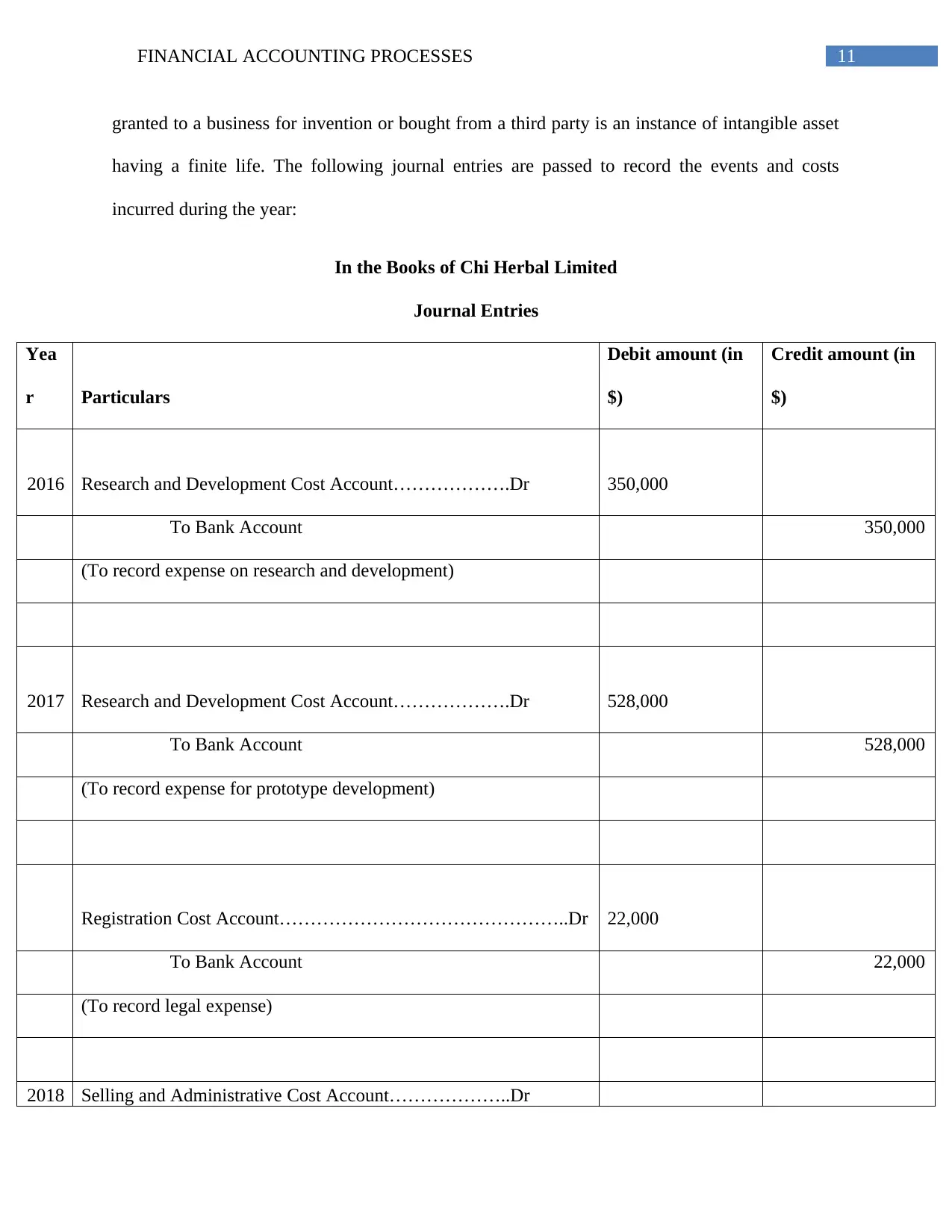
11FINANCIAL ACCOUNTING PROCESSES
granted to a business for invention or bought from a third party is an instance of intangible asset
having a finite life. The following journal entries are passed to record the events and costs
incurred during the year:
In the Books of Chi Herbal Limited
Journal Entries
Yea
r Particulars
Debit amount (in
$)
Credit amount (in
$)
2016 Research and Development Cost Account……………….Dr 350,000
To Bank Account 350,000
(To record expense on research and development)
2017 Research and Development Cost Account……………….Dr 528,000
To Bank Account 528,000
(To record expense for prototype development)
Registration Cost Account………………………………………..Dr 22,000
To Bank Account 22,000
(To record legal expense)
2018 Selling and Administrative Cost Account………………..Dr
granted to a business for invention or bought from a third party is an instance of intangible asset
having a finite life. The following journal entries are passed to record the events and costs
incurred during the year:
In the Books of Chi Herbal Limited
Journal Entries
Yea
r Particulars
Debit amount (in
$)
Credit amount (in
$)
2016 Research and Development Cost Account……………….Dr 350,000
To Bank Account 350,000
(To record expense on research and development)
2017 Research and Development Cost Account……………….Dr 528,000
To Bank Account 528,000
(To record expense for prototype development)
Registration Cost Account………………………………………..Dr 22,000
To Bank Account 22,000
(To record legal expense)
2018 Selling and Administrative Cost Account………………..Dr
⊘ This is a preview!⊘
Do you want full access?
Subscribe today to unlock all pages.

Trusted by 1+ million students worldwide
1 out of 14
Related Documents
Your All-in-One AI-Powered Toolkit for Academic Success.
+13062052269
info@desklib.com
Available 24*7 on WhatsApp / Email
![[object Object]](/_next/static/media/star-bottom.7253800d.svg)
Unlock your academic potential
Copyright © 2020–2025 A2Z Services. All Rights Reserved. Developed and managed by ZUCOL.



